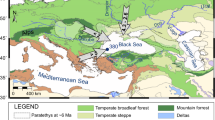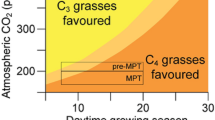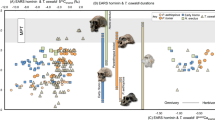Abstract
Modern savannah grasslands were established during the late Miocene and Pliocene (8–3 million years ago)1,2. In the tropics, grasslands are dominated by grasses that use the C4 photosynthetic pathway, rather than the C3 pathway. The C4 pathway is better adapted to warm, dry and low-CO2 conditions, leading to suggestions that declining atmospheric CO2 levels3, increasing aridity and enhanced rainfall seasonality allowed grasses using this pathway to expand1,2,4 during this interval. The role of fire in C4 expansion may have been underestimated1,5,6,7. Here we use analyses of pollen, microscopic charcoal and the stable isotopic composition of plant waxes from a marine sediment core off the coast of Namibia to reconstruct the relative timing of changes in plant composition and fire activity for the late Miocene and Pliocene. We find that in southwestern Africa, the expansion of C4 grasses occurred alongside increasing aridity and enhanced fire activity. During further aridification in the Pliocene, the proportion of C4 grasses in the grasslands increased, while the grassland contracted and deserts and semi-deserts expanded. Our results are consistent with the hypothesis1,5,6,7 that ecological disturbance by fire was an essential feedback mechanism leading to the establishment of C4 grasslands in the Miocene and Pliocene.
This is a preview of subscription content, access via your institution
Access options
Subscribe to this journal
Receive 12 print issues and online access
$259.00 per year
only $21.58 per issue
Buy this article
- Purchase on Springer Link
- Instant access to full article PDF
Prices may be subject to local taxes which are calculated during checkout


Similar content being viewed by others
References
Edwards, E. J. et al. The origins of C4 grasslands: Integrating evolutionary and ecosystem science. Science 328, 587–591 (2010).
Strömberg, C. A. E. Evolution of grasses and grassland ecosystems. Annu. Rev. Earth Planet. Sci. 39, 517–544 (2011).
Cerling, T. E. et al. Global vegetation change through the Miocene/Pliocene boundary. Nature 389, 153–158 (1997).
Sage, R. F. Environmental and evolutionary preconditions for the origin and diversification of the C4 photosynthetic syndrome. Plant Biol. 3, 202–213 (2001).
Osborne, C. P. Atmosphere, ecology and evolution: What drove the Miocene expansion of C4 grasslands? J. Ecol. 96, 35–45 (2008).
Beerling, D. J. & Osborne, C. P. The origin of the savanna biome. Glob. Change Biol. 12, 2023–2031 (2006).
Keeley, J. E. & Rundel, P. W. Fire and the Miocene expansion of C4 grasslands. Ecol. Lett. 8, 683–690 (2005).
Urban, M. A. et al. Isotopic evidence of C4 grasses in southwestern Europe during the Early Oligocene-Middle Miocene. Geology 38, 1091–1094 (2010).
Vicentini, A., Barber, J. C., Aliscioni, S. S., Giussani, L. M. & Kellogg, E. A. The age of the grasses and clusters of origins of C4 photosynthesis. Glob. Change Biol. 14, 2963–2977 (2008).
Pagani, M., Zachos, J. C., Freeman, K. H., Tipple, B. & Bohaty, S. Marked decline in atmospheric carbon dioxide concentrations during the Paleogene. Science 309, 600–603 (2005).
Ehleringer, J. R., Cerling, T. E. & Helliker, B. R. C4 photosynthesis, atmospheric CO2, and climate. Oecologia 112, 285–299 (1997).
Scheiter, S. et al. Fire and fire-adapted vegetation promoted C4 expansion in the late Miocene. New Phytol. 195, 653–666 (2012).
White, F. The Vegetation of Africa, Natural Resources Research (UNESCO, 1983).
Dupont, L. M., Donner, B., Vidal, L., Pérez, E. M. & Wefer, G. Linking desert evolution and coastal upwelling: Pliocene climate change in Namibia. Geology 33, 461–464 (2005).
Dupont, L. M. & Wyputta, U. Reconstructing pathways of aeolian pollen transport to the marine sediments along the coastline of SW Africa. Quat. Sci. Rev. 22, 157–174 (2003).
Still, C. J. & Powell, R. L. in Isoscapes: Understanding Movement, Pattern, and Process on Earth Through Isotope Mapping (eds West, J. B., Bowen, G. J., Dawson, T. E. & Tu, K. P.) 179–193 (Springer, 2010).
Eglinton, G. & Hamilton, R. J. Leaf epicuticular waxes. Science 165, 1322–1335 (1967).
Vogts, A., Moossen, H., Rommerskirchen, F. & Rullkötter, J. Distribution patterns and stable carbon isotopic composition of alkanes and alkan-1-ols from plant waxes of African rain forest and savanna C3 species. Org. Geochem. 40, 1037–1054 (2009).
Ségalen, L. et al. Neogene climate change and emergence of C4 grasses in the Namib, southwestern Africa, as reflected in ratite 13C and 18O. Earth Planet. Sci. Lett. 244, 725–734 (2006).
Feakins, S. J. et al. Northeast African vegetation change over 12 m.y. Geology 41, 295–298 (2013).
Rommerskirchen, F., Condon, T., Mollenhauer, G., Dupont, L. & Schefuß, E. Miocene to Pliocene development of surface and subsurface temperatures in the Benguela Current system. Paleoceanography 26, 1–15 (2011).
Furley, P. A., Rees, R. M., Ryan, C. M. & Saiz, G. Savanna burning and the assessment of long-term fire experiments with particular reference to Zimbabwe. Prog. Phys. Geograph. 32, 611–634 (2008).
Bond, W. J. What Limits Trees in C4 Grasslands and Savannas? Annu. Rev. Ecol. Evolut. Syst. 39, 641–659 (2008).
Bond, W. J., Midgley, G. F. & Woodward, F. I. What controls South African vegetation—climate or fire? South Afr. J. Bot. 69, 79–91 (2003).
Visser, V., Woodward, F. I., Freckleton, R. P. & Osborne, C. P. Environmental factors determining the phylogenetic structure of C4 grass communities. J. Biogeogr. 39, 232–246 (2012).
Klaassen, E. S. & Craven, P. Checklist of Grasses in Namibia (Southern African Botanical Diversity Network No. 20. SABONET, 2003).
Morley, R. & Richards, K. Gramineae cuticle: A key indicator of Late Cenozoic climatic change in the Niger Delta. Rev. Palaeobot. Palynol. 77, 119–127 (1993).
Maher, L. J. J. Nomograms for computing 0.95 confidence limits of pollen data. Rev. Palaeobot. Palynol. 13, 85–93 (1971).
Müller, P. J., Kirst, G., Ruhland, G., von Storch, I. & Rosell-Melé, A. Calibration of the alkenone paleotemperature index U37K′ based on core-tops from the eastern South Atlantic and the global ocean (60° N–60° S). Geochim. Cosmochim. Acta 62, 1757–1772 (1998).
Acknowledgements
This work was supported by the DFG Research Center/Cluster of Excellence ‘MARUM—The Ocean in the Earth System’ and ‘GLOMAR—Bremen International Graduate School for Marine Sciences’. F.R. was supported by the Deutsche Forschungsgemeinschaft (Sche903/6) within the research unit ‘Understanding Cenozoic Climate Cooling: The Role of the Hydrology Cycle, the Carbon Cycle, and Vegetation Changes’ (FOR 1070). Twentieth Century Reanalysis data were provided by the NOAA/OAR/ESRL PSD, Boulder, Colorado, USA, from their website at http://www.esrl.noaa.gov/psd. Global fire map data were provided by NASA Earth Data from their website at https://earthdata.nasa.gov/.
Author information
Authors and Affiliations
Contributions
Palynological data analysis was carried out by S.H. and biogeochemical data by F.R. Interpretation was carried out by S.H., L.D., E.S., F.R. and G.W.
Corresponding author
Ethics declarations
Competing interests
The authors declare no competing financial interests.
Supplementary information
Supplementary Information
Supplementary Information (PDF 888 kb)
Rights and permissions
About this article
Cite this article
Hoetzel, S., Dupont, L., Schefuß, E. et al. The role of fire in Miocene to Pliocene C4 grassland and ecosystem evolution. Nature Geosci 6, 1027–1030 (2013). https://doi.org/10.1038/ngeo1984
Received:
Accepted:
Published:
Issue Date:
DOI: https://doi.org/10.1038/ngeo1984
This article is cited by
-
Disruption of trait-environment relationships in African megafauna occurred in the middle Pleistocene
Nature Communications (2023)
-
Effects of simulated fire and browsing on the resprouting of subtropical dune thicket shrubs in the southeastern Cape Floristic Region
Plant Ecology (2023)
-
Astronomically controlled aridity in the Sahara since at least 11 million years ago
Nature Geoscience (2022)
-
Modelling the effects of CO2 on C3 and C4 grass competition during the mid-Pleistocene transition in South Africa
Scientific Reports (2020)
-
The contribution of fire to the late Miocene spread of grasslands in eastern Eurasia (Black Sea region)
Scientific Reports (2019)



